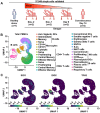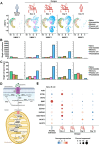Activation of the IDO1-GCN2-ATF4-CHOP Pathway During the Massive Generation of Antibody-Secreting Cells in Dengue Patients Through Single-Cell Transcriptomics
- PMID: 40575112
- PMCID: PMC12198583
- DOI: 10.1177/11786469251340237
Activation of the IDO1-GCN2-ATF4-CHOP Pathway During the Massive Generation of Antibody-Secreting Cells in Dengue Patients Through Single-Cell Transcriptomics
Abstract
Dengue, a widespread mosquito-borne disease, annually afflicts millions globally, posing substantial mortality risks. Preceding disease defervescence, a marked and transient surge in antibody-secreting cell (ASC) frequency correlates with disease severity, paralleled by heightened tryptophan degradation. Investigating details of this process through single-cell transcriptomics from public repositories, our data pinpoint CD14+ monocytes as principal IDO1 and IDO2 expressors, implicating them, rather than B cells, in initiating tryptophan metabolism. Interestingly, naive B cells exhibit altered gene expression indicative of early impact by tryptophan deficiency before defervescence with a potential impact on the B cell fate. Dengue-induced ASCs upregulated GCN2, PERK, eIF2a, ATF4 genes as well as BIM and CASP-3. However, the high expression of anti-apoptotic genes (FKBP8 [a CHOP-regulated gene], BCL-XL, BCL-2, MCL-1) allows enhanced ASC survival. Proliferation and differentiation-related genes (eIF4EBP1, RRM2, and HIF1a) were also upregulated in ASCs. These findings untangle how Dengue modulates the host metabolism and B-cell responses, although further research is needed to fully understand their implications on disease progression.
Keywords: B cells; blood; kynurenine; tryptophan metabolism; viral infection.
© The Author(s) 2025.
Conflict of interest statement
The author(s) declared no potential conflicts of interest with respect to the research, authorship, and/or publication of this article.
Figures




References
-
- WHO. Dengue and severe dengue. 2024. Accessed May 15, 2024. https://www.who.int/news-room/fact-sheets/detail/dengue-and-severe-dengue
LinkOut - more resources
Full Text Sources
Research Materials
Miscellaneous

